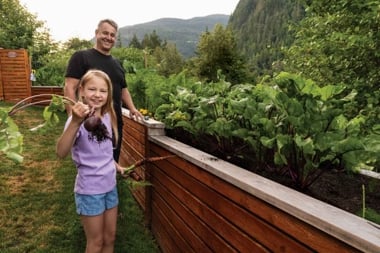Tasty Tubers
Why bother growing potatoes when they are so cheap at the supermarket and they store so well? The best reason is that by harvesting potatoes from your own garden you safeguard your health. Potatoes may cany residues of any number of pesticides. Another reason is that many potatoes now being sold are genetically engineered to produce a soil bacteria that kills pests such as the Colorado Potato Beetle.
Why bother growing potatoes when they are so cheap at the supermarket and they store so well?
The best reason is that by harvesting potatoes from your own garden you safeguard your health. Potatoes may cany residues of any number of pesticides. Another reason is that many potatoes now being sold are genetically engineered to produce a soil bacteria that kills pests such as the Colorado Potato Beetle. There is much controversy about these potatoes, from health concerns to serious environmental problems, so grow your own from standard varieties that do well in your area.
You can purchase seed potatoes from garden centres or from mailorder nurseries. Though store-bought potatoes can be planted, it is better to use organic-certified, disease-free tubers that have sprouts or "eyes."
Lay them out in a light, warm area for a few weeks before planting. The light ensures the eyes are short and strong so they do not break off when planting. Once the eyes are about two and a half centimetres (one inch) long, the potatoes are ready. Cut them into portions (or sets) and let dry for 24 to 48 hours before planting to avoid rot and potential fungi.
Dig a trench about two feet deep (half a metre) and fill with soil and compost. Mediums like layers of straw or leaves can be used instead of soil. These have the advantage of allowing you to dig in with your hands instead of using a shovel or fork when you harvest, with less likelihood of damaging the tubers. Another advantage is that you can remove only as many potatoes as desired, leaving the rest fresher for harvesting later on.
Plant sets in full sun, with cut surface down. Cover with soil or other medium but don't bury too deeply. The potatoes will grow along the stem of the plant, so continue to mound around the plant with soil or other medium, covering the potatoes as they develop. This is important, because if the cover becomes too thin the sunlight can cause the tubers to turn green, which is toxic. The potato plant has the ability to produce its own protective chemicals which can make it lethal to insects and fungi that attack it. These protective chemicals (glycoalkaloids) are at high levels in the leaves, stems and sprouts and are normally at low levels in potato tubers. When exposed to light however, the tuber will produce elevated levels of glycoalkaloids. They are not destroyed by cooking, so potatoes with pronounced greening should not be eaten, as they may cause food poisoning.
Plant the sets only about 15 centimetres (six inches) apart to keep the size of the potatoes from becoming too large. A uniform supply of water is important, so water regularly throughout the season if the weather is dry. If given water too suddenly, potatoes may crack and become misshapen. Potatoes also tend to become hollow if the plants are allowed to get too dry.
Potatoes are ripe when the vines begin to flower. You can dig a few at this time to serve with garden mint and butter. Harvest the remainder of the tubers when the vines wither. The potatoes can be left in the ground after the vines have died but should be harvested before hard frost.
Potatoes can be stored for long periods of time in a cool, dark area, but do not store them with onions. Though they need the same conditions for storage, potatoes cause onions to rot and onions cause potatoes to sprout.
This summer, dig out a few potatoes from your very own garden and serve them at your table, proudly and safely!




